3.2.1 to 3.2.8
Course subject(s)
3. Real Time Traffic Control
3.2.1 Purpose of a Timetable
Why do we make a timetable?
There are four main reasons why we make timetables:
- Information to the passengers
Operational perspective for the traveler is a service provided by most public transport systems. The passengers use the timetable to plan their trip. Having a timetable allows them to do this. - Allocation of resources
The timetable shows which train should be where throughout the day. This is used to determine when and where rolling stock and train crew should be ready. This cannot be scheduled without a timetable. - Train traffic management
The timetable is the starting point for realtime traffic management. It is how the trains travel when everything is going according to plan. This published plan is the desired level of operation. When a disruption occurs this plan cannot be followed anymore. The traffic manager (train dispatcher) makes an alternative plan. After clearing a disruption the alternative plan is brought back to the level of the published plan. - Capacity analysis
The test of the available rail capacity fits with the train traffic demand. Therefore, we use time distance diagrams.
3.2.2 Design Process
Obtaining a workable timetable design isn’t as simple as inputing everything into a single software package; it takes several steps and pieces of software. In general, the design process can be divided into 4 main steps, illustrated in the figure below.
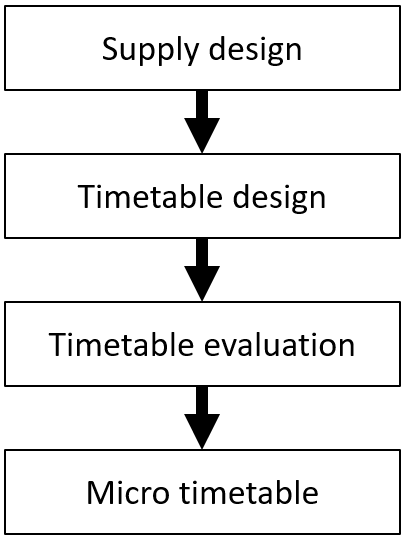 The first step is creating a supply design. A supply design defines how you want the trains to run throughout the available network. You decide which train you want to have at a place in the network, based on the passenger demands. The design outlines the route of the trains, where the trains stop and what the frequency of the trains is (given in the number of trains per hour). For passenger transport, making a supply design is a process of many choices.
The first step is creating a supply design. A supply design defines how you want the trains to run throughout the available network. You decide which train you want to have at a place in the network, based on the passenger demands. The design outlines the route of the trains, where the trains stop and what the frequency of the trains is (given in the number of trains per hour). For passenger transport, making a supply design is a process of many choices.- Now that you have a supply design, it is time for the next step: creating a timetable design. The supply design gives the desired train frequency of trains on the network, but it does not tell you if this will actually fit. Timetabling is the placement of a supply design in time. Using timetabling software, a so-called time-distance diagram is generated showing what the supply design would look like when placed in time. If the results do not fit in time, the supply design is adjusted. The final result of this step is a workable timetable for a certain supply design.
- The next step in the design process is to evaluate the obtained timetable. Two common evaluations are an evaluation based on passenger demand and an evaluation based on disruptions.
- The first evaluation matches the created timetable with the actual passenger demand. The timetable and a passenger prognosis is put in a program to determine how full the trains in the network will be. If trains are overfull or empty at places in the network, it means that the supply design needs to be adjusted.
- The second evaluation method evaluates the robustness of the design by randomly creating disruptions in a simulation, which is based on real-life cases. If the disruptions naturally dampen, then the design is sufficient. When the timetable passes all evaluation methods it is considered good enough to be executed.
- Now that we have a definitive timetable, all sub-processes need to be scheduled. These are all the processes required to actually execute the timetable. Employees are needed, trains need to be coupled and decoupled at the right time, etc. This is called micro timetabling. Once this step is completed, the process is finished and we have obtained a workable and executable timetable for the network.
3.2.3 Timetable design
The supply design defines how the trains will run throughout the network. Specifically, it outlines:
- The route of the trains,
- Where the train stops,
- The frequency of the train (how many trains per hour).
It is not yet a timetable. That is the next step.
Below, you can see an example of a supply design.
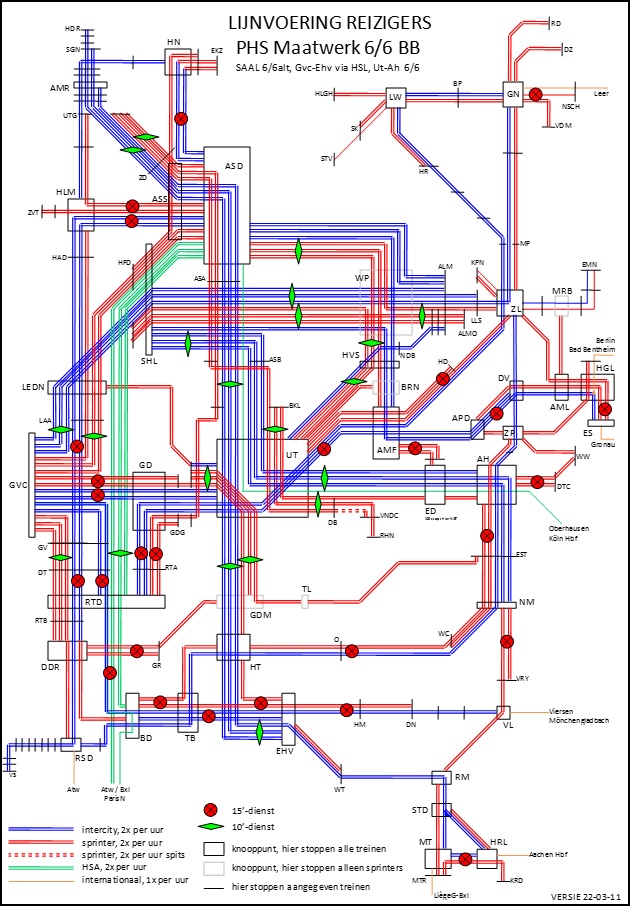
This is based on the Programme Train Transport with High Frequencies in the Netherlands, which will be discussed in more detail later this week. This is just to give you an idea of the complexity of a dense network.
You see high speed lines (green), Interstate lines (blue) and Local lines (red).
For passenger transport, making a supply design is a process of many choices because there are many criteria to take into account.
Sometimes, these criteria conflict, and sometimes criteria are not fully rational, such as political wishes. Therefore, most supply designs are hand-crafted, and supported by many tools for evaluation. There are some developments, using Artificial Intelligence, but they have not yet been particularly successful.
In the next units, we will discuss several design dilemmas related to timetabling.
3.2.4 Supply Design: Dilemmas 1
Design dilemma 1
The first dilemma is the number of stops. This is a dilemma between speed and accessibility of the train system. When you add stops, more people have a train stop near their house or destination. The consequence is that the average speed of the train decreases.

The main considerations are:
| Many stops | Few stops |
| High accessibility | Low accessibility |
| Low speed | High speed |
Travelers prefer high accessibility. But, for the train operating companies, new stations are often not profitable. The cost of longer driving times are higher than the revenue from the new passengers. At present, in the Netherlands, there are approximately 100 requests for new stations (mostly political wishes).
Another factor to consider is the optimal stop-distance depending on the travel distance. Five levels of scale can be defined as given in the table below.
| Level of scale | Average distance between stops | Travel distances | Means of transport |
| international | 100 km | 300 – 1000 km | high speed train |
| national | 30 km | 80 – 300 km | intercity train |
| interregional | 10 km | 40 – 100 km | express train |
| regional | 3 km | 20 – 50 km | regional train |
| conurban | 1 km | 5 – 30 km | light train/metro |
Design dilemma 2
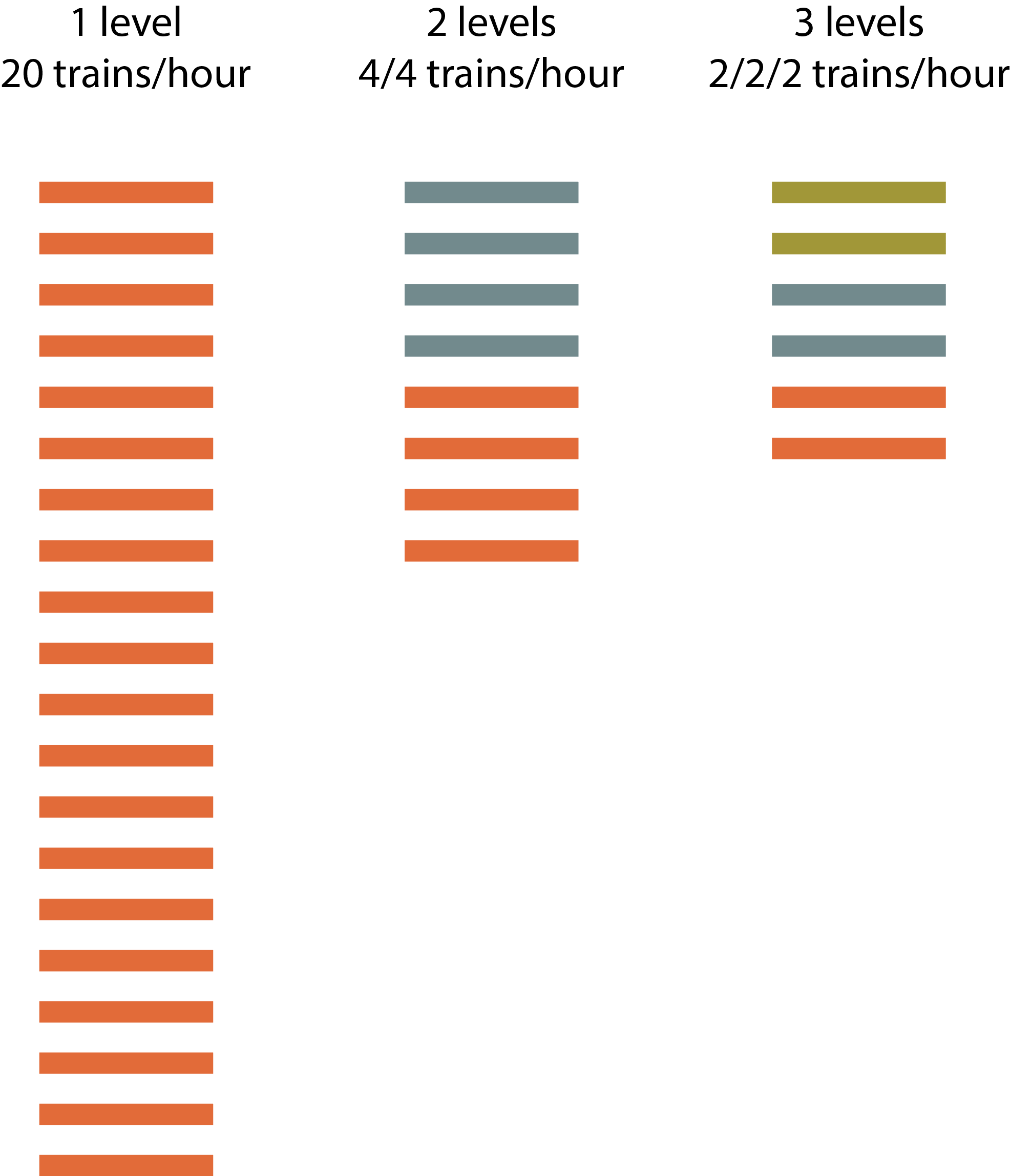
The next dilemma is: how many levels of scale should you offer on one line?
Speed differentiation is very important for the capacity of a rail track (you will learn more about that later). The rule of thumb for the number of levels of scale and the capacity of a single track are given in the figure below. As you can see, the more different levels exist on one track the lower the capacity.
The main considerations are:
| More levels of scale | Fewer levels of scale |
| more stations in a higher system | greater total capacity |
| lower travel time between main stations | greater robustness of the operations |
A well-known system with one level of scale is the metro system. All trains have the same speed, size and number of stops. This results in a high capacity and a very robust system. The downside is: relatively longer travel times between main stations. For a national train system, this is unsuitable, as it would displease the traveler (especially commuters). Therefore, a second or even third level of scale is introduced on the same tracks. These trains stop at fewer stations, reducing the travel time between main stations, which better suits traveler-demand. But, the consequence is that the total capacity goes down.
3.2.5 Supply Design: Dilemmas 2
Design dilemma 3
A next dilemma is the coupling of lines through a main station. There are three ways of coupling lines or not:
- Radial: turning of trains in the main station. (Upper line)
- Transversal: coupling of lines through the main station, no turning of trains. (Middle line)
- Semi-transversal: the trains don’t turn at the main station, but one or some stations further on. (Lower line)
The main considerations are:
| Coupling of lines | Turning of trains |
| more direct connections without transfer | balanced train occupancy |
| less turning trains | more robustness in operation |
| less transferring travellers |
Coupling of lines are often preferable because of the positive effect on track and station capacity. Less turning trains means the track capacity goes up. Less transferring travelers means fewer transport flows on the stations. This is positive for the station capacity. Furthermore, travelers prefer fewer transfers. A downside of coupling is that the size of the train is based on the busiest section of track. This means that there will be sections where you will run trains that are bigger than necessary. By turning trains the train occupancy is more balanced. Semi-transversal lines are used when turning on the main station is very difficult, because of track capacity. The main example is Schiphol. There the trains run through to Hoofddorp for turning there.
Design dilemma 4
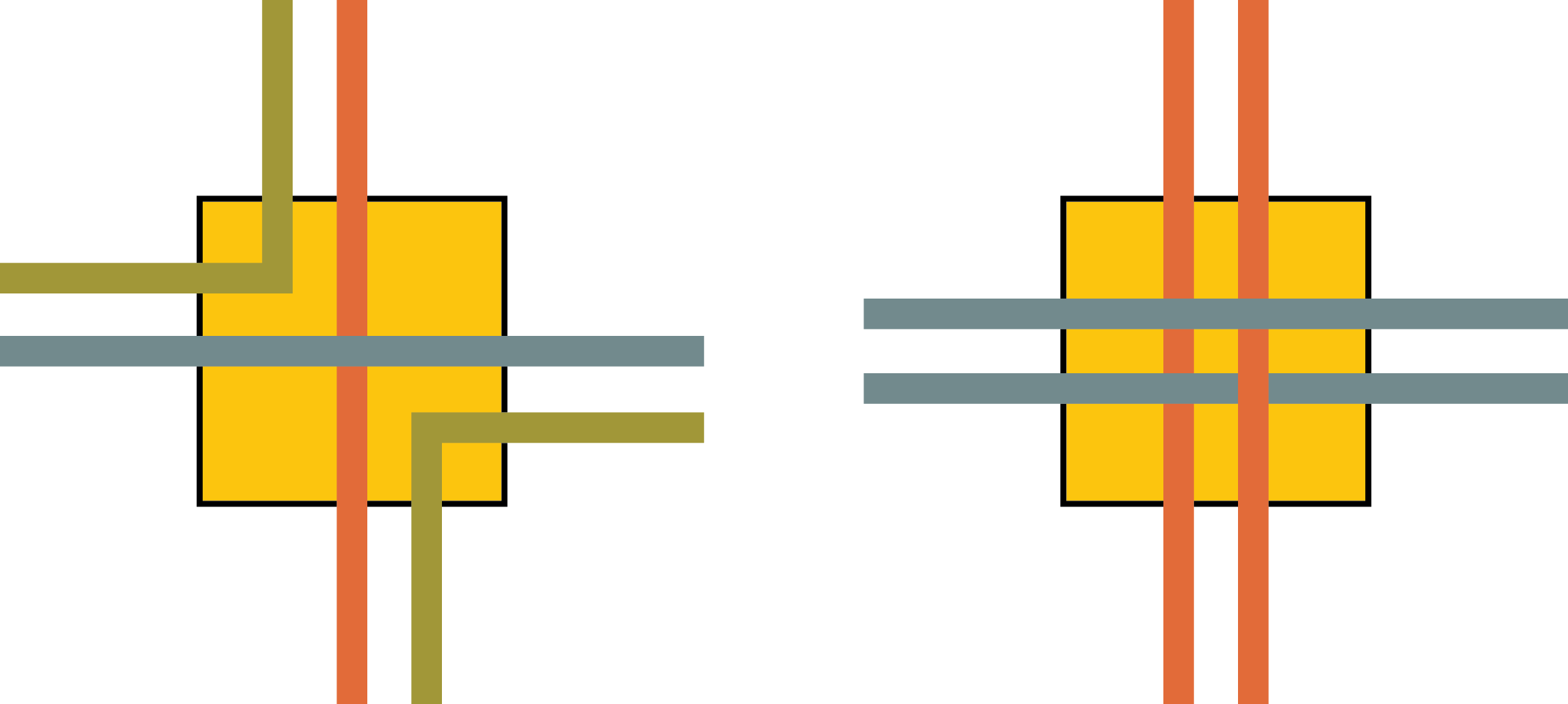
The last dilemma we discuss is the choice between direct train services (without transfer) or high frequencies. In professional terms: alternating or stretched. The image shows alternating lines on the left and stretched lines on the right.
The main considerations are:
| Alternating | Stretched |
| fewer transferring travellers | higher frequency on essential connection |
| greater robustness in operation |
When the connections are all more or less equal, we usually choose alternating. This means that travellers have fewer transfers, which is preferable. When one connection is distinctly important, we usually choose stretched lines.
The red and blue lines in the figures go from one track to two tracks. This means a high frequency is possible for the busiest connections. Travellers going off a main line will have to transfer, but the number of travellers doing so is limited. Therefore, no direct line is necessary, which frees up track for the main lines.
3.2.6 Timetable design
Introduction
You have seen what a supply design looks like and what kind of dilemmas arise when designing one. The second step in the design process is designing a timetable for the determined supply design. As explained previously, software places your supply design in time. The result is a time-distance diagram of your supply design. This is the timetable. The following video explains what the time-distance diagram represents.
Animation video: Time-Distance Diagram
Sorry but there don't seem to be any downloads..
Subtitles (captions) in other languages than provided can be viewed at YouTube. Select your language in the CC-button of YouTube.
3.2.7 Governance
A very large determining factor in making supply designs and timetables is the governance: the juridical and financial relations in the rail system. Those relations differ per train type. The four main distinguishable train services are international, national, regional, and freight trains.
Different train services are run by different train operating companies. These train operating companies make their own supply designs. Some companies have to make concessions. Their supply design has to meet certain requirements. There are also differences in finances. Some companies get subsidies, while others have to pay concession fees. The table below gives a quick overview of these aspects for the four main train services.
| Kind of train service | Train operating companies | Concession | Costs train operating companies | Subsidy to train operating companies |
| International | National train operating companies, in cooperation with companies from other countries | None, free market | None | None |
| National | National train operating companies | HRN-concession (Head Rail Network) with the Department of Transport,requirements for the main features |
Concession fee (to the Department of Transport),dividend (to the Department of Finance) | Limited, only for additional train services by regional authorities |
| Regional | Regional train operating companies | Regional concessions with regional authorities,detailed requirements | none | Quite large subsidies from the regional authorities |
| Freight | Freight carriers | None, free market | None | None |
Notice the differences in concessions:
- National train operating companies can make their own supply design with only some restrictions. They get requirements for the main features on the Head Rail Network (NS).
- The supply design of regional networks is highly prescribed by the regional authorities. There are detailed requirements in the regional concessions.
- There are no concessions for international trains and freight trains.
And notice the differences in finance:
- National train operating companies have to pay for the concession of the Head Rail Network.
- Regional train operating companies get subsidies from the government.
- International trains and freight trains are free markets.
3.2.8 Head Rail vs Regional
When we look at the previous table we see that there is a large difference between national and regional trains. This is because of the distinction in the Head Rail Network and regional networks.
When you look at the map below (Dutch situation in 2013) you see that there are many different train operating companies in the Netherlands. Every train operating company must have an admittance agreement with the rail infrastructure manager and they have to pay user fees to the rail infrastructure manager for the use of the railway network. The rail infrastructure manager has a management concession with the Department of Transport and gets a management fee. Most of the smaller train operating companies are in regional areas. In this case, the Head Rail Network is run by only one company (blue) and covers the dense populated area and main connections inland.
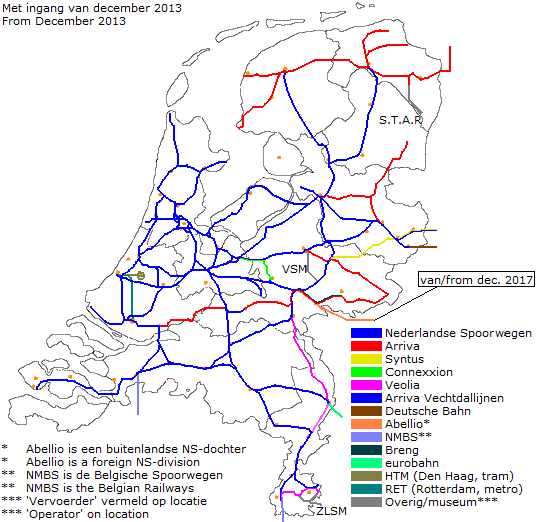
Head Rail Network is run by companies that create supply designs according to the travel market. Most trains travel where most travelers are. This creates the most profitable operation. The government gets concession fees and dividend from the train operating companies but is not in the position to give strict requirements for the supply design.
The regional networks are often not run by the same companies as the Head Rail Network. These companies want to have a profitable operation and that is rarely possible in regional areas due to the small amount of travelers. The companies are more likely to lose money in these areas. So regional networks are only profitable when subsidised. The government pays the train operating companies to make sure trains travel through these more remote areas with a regular frequency in order to accommodate the travelers. Since the government invests in these companies they also give detailed requirements for the supply design.
This division between the two networks is a logical construction and occurs in most countries. This becomes clear when considering what happens when the complete network is managed by one system.
If the regional networks are also run by the same companies that take care of the Head Rail Network, then the supply design in these areas would be created according to the travel market. This means that trains will travel with much lower frequencies or not at all. There will also be less stations. This is the only way that the operation remains profitable. The government does not have to subsidise anymore but the network will become very inconvenient for travellers living outside of the main urban areas.
If the Head Rail Network is given detailed requirements by the government, then the main focus would not be profit but traveler satisfaction. This means higher frequencies of trains and more stations. The result is that operations become less profitable. Therefore, the government will receive less concession fees and dividend from the train operating companies or would even have to pay subsidy to the train operating company. Doing this for an entire country would make the train network far too expensive for the government.

Railway Engineering: An Integral Approach by TU Delft OpenCourseWare is licensed under a Creative Commons Attribution-NonCommercial-ShareAlike 4.0 International License.
Based on a work at https://ocw.tudelft.nl/courses/railway-engineering-integral-approach/.




